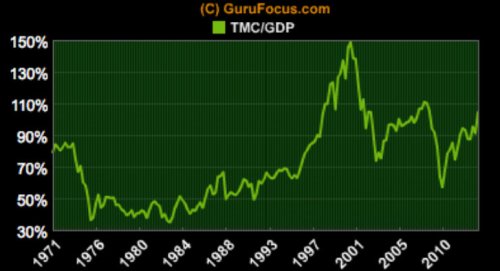Stocks Priced in Real GDP
Since the 1990s, priced in Real GDP the Dow Jones Industrial Average (as well as the S&P500) has been far above their 20th-century norm:

There is an unsurprising coincidence — as stock prices (and corporate profits) have soared above their historical norm, wage growth has been very stagnant. The economy has come to be tilted toward bankers, financiers, insurance brokers and away from wage-earners, manufacturers and artisans.
Does that mean that as Hassett and Glassman projected in Dow 36,000, stock prices have climbed to a new plateau? Well, while it is impossible to say exactly what prices will do in future (nominal, or otherwise) the “new plateau” has been very much supported by the Federal Reserve, first by lowering rates and keeping them low:

And second through expanding the monetary base by buying securities directly (Bernanke estimates a simulated interest rate decrease of 0.25% for each 250 billion dollars of quantitative easing):

Each time stocks have turned cheaper, the Fed has stepped in and eased, and stocks have reversed upward.
Some might take that as a sign that stocks aren’t going to get much cheaper, because the Fed won’t let them get much cheaper. First under Greenspan, and second under Bernanke the Fed has succeeded at reinflating the bubble. But the secular trend is back toward the pre-1990s norm. Gravity is against the Fed. The Fed (to use a tired old metaphor) is Atlas, holding stock prices up on its shoulders. Will it be third-time unlucky for the Fed, hell-bent on wealth-effecting and financialising the US economy to prosperity?
Source: http://azizonomics.com/2013/03/24/st...d-in-real-gdp/
----
Some really powerful graphs that clearly show the monetary regime change and asset inflation it engendered since the early 80s.
US total debt began to rise at the same time asset prices diverged from GDP:

I agree with the author that this is probably mean-reverting, either through another asset market collapse a la 2008, or through mass debt monetization and government deficit spending that sends the CPI higher.
March 24, 2013
Aziz Economics, Finance, Wall Street dow 36000, economy, glassman, hassett, new plateau, real gdp, stocks, wealth effect 17 CommentsSince the 1990s, priced in Real GDP the Dow Jones Industrial Average (as well as the S&P500) has been far above their 20th-century norm:

There is an unsurprising coincidence — as stock prices (and corporate profits) have soared above their historical norm, wage growth has been very stagnant. The economy has come to be tilted toward bankers, financiers, insurance brokers and away from wage-earners, manufacturers and artisans.
Does that mean that as Hassett and Glassman projected in Dow 36,000, stock prices have climbed to a new plateau? Well, while it is impossible to say exactly what prices will do in future (nominal, or otherwise) the “new plateau” has been very much supported by the Federal Reserve, first by lowering rates and keeping them low:

And second through expanding the monetary base by buying securities directly (Bernanke estimates a simulated interest rate decrease of 0.25% for each 250 billion dollars of quantitative easing):

Each time stocks have turned cheaper, the Fed has stepped in and eased, and stocks have reversed upward.
Some might take that as a sign that stocks aren’t going to get much cheaper, because the Fed won’t let them get much cheaper. First under Greenspan, and second under Bernanke the Fed has succeeded at reinflating the bubble. But the secular trend is back toward the pre-1990s norm. Gravity is against the Fed. The Fed (to use a tired old metaphor) is Atlas, holding stock prices up on its shoulders. Will it be third-time unlucky for the Fed, hell-bent on wealth-effecting and financialising the US economy to prosperity?
Source: http://azizonomics.com/2013/03/24/st...d-in-real-gdp/
----
Some really powerful graphs that clearly show the monetary regime change and asset inflation it engendered since the early 80s.
US total debt began to rise at the same time asset prices diverged from GDP:

I agree with the author that this is probably mean-reverting, either through another asset market collapse a la 2008, or through mass debt monetization and government deficit spending that sends the CPI higher.









Comment